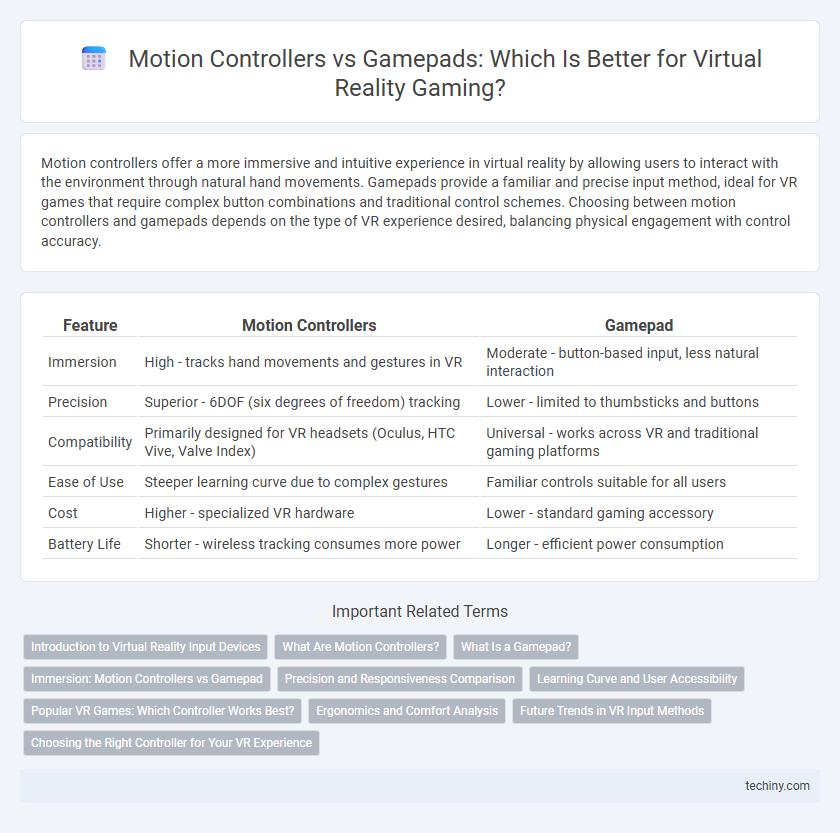Motion controllers offer a more immersive and intuitive experience in virtual reality by allowing users to interact with the environment through natural hand movements. Gamepads provide a familiar and precise input method, ideal for VR games that require complex button combinations and traditional control schemes. Choosing between motion controllers and gamepads depends on the type of VR experience desired, balancing physical engagement with control accuracy.
Table of Comparison
| Feature | Motion Controllers | Gamepad |
|---|---|---|
| Immersion | High - tracks hand movements and gestures in VR | Moderate - button-based input, less natural interaction |
| Precision | Superior - 6DOF (six degrees of freedom) tracking | Lower - limited to thumbsticks and buttons |
| Compatibility | Primarily designed for VR headsets (Oculus, HTC Vive, Valve Index) | Universal - works across VR and traditional gaming platforms |
| Ease of Use | Steeper learning curve due to complex gestures | Familiar controls suitable for all users |
| Cost | Higher - specialized VR hardware | Lower - standard gaming accessory |
| Battery Life | Shorter - wireless tracking consumes more power | Longer - efficient power consumption |
Introduction to Virtual Reality Input Devices
Motion controllers provide immersive and intuitive interaction in virtual reality by tracking hand movements and gestures with precision, enhancing user engagement and presence. Gamepads offer a familiar input method that supports VR experiences through analog sticks and buttons, suitable for users transitioning from traditional gaming. Choosing between motion controllers and gamepads depends on the desired level of immersion and interaction complexity within VR environments.
What Are Motion Controllers?
Motion controllers are handheld devices designed to capture users' physical movements and translate them into virtual actions within a VR environment. Unlike traditional gamepads, motion controllers use sensors such as accelerometers, gyroscopes, and infrared trackers to provide precise tracking of hand gestures and spatial orientation. These controllers enhance immersion by enabling natural, intuitive interaction with virtual objects, making VR experiences more engaging and lifelike.
What Is a Gamepad?
A gamepad is a handheld input device featuring buttons, triggers, and analog sticks designed for intuitive control in video gaming, commonly used across consoles and PCs. Unlike motion controllers that track physical movements in 3D space for immersive interaction, gamepads provide precise, button-based inputs ideal for traditional gameplay styles. In virtual reality, gamepads serve as familiar controllers when motion tracking is not required or unavailable, offering a straightforward interface for navigation and gameplay.
Immersion: Motion Controllers vs Gamepad
Motion controllers significantly enhance immersion in virtual reality by providing natural hand movements and precise interaction with the virtual environment, closely mimicking real-world actions. Gamepads offer less intuitive control schemes, limiting the sense of presence due to indirect input methods and reduced spatial awareness. Motion controllers enable more dynamic and embodied experiences, deepening user engagement and realism in VR applications.
Precision and Responsiveness Comparison
Motion controllers offer superior precision and responsiveness compared to traditional gamepads by tracking hand movements in real-time, enhancing immersive interactions in virtual reality environments. Advanced sensors and low-latency tracking systems enable motion controllers to capture subtle gestures and rapid actions with high accuracy. Gamepads provide reliable input but lack the spatial tracking capabilities essential for detailed motion detection, limiting their effectiveness in VR precision tasks.
Learning Curve and User Accessibility
Motion controllers provide intuitive, natural gestures that significantly reduce the learning curve for VR users, offering enhanced immersion through direct hand tracking. Gamepads, familiar to most gamers, present a more accessible option for beginners but may hinder full VR interaction due to limited motion input. Choosing between these devices impacts user comfort and engagement, influencing overall VR experience quality.
Popular VR Games: Which Controller Works Best?
Motion controllers provide precise hand tracking and intuitive gestures, enhancing immersion in popular VR games like Beat Saber and Half-Life: Alyx. Gamepads offer familiar button layouts and ease of use, favored in VR titles such as No Man's Sky and Resident Evil 7 for traditional gameplay styles. The choice depends on game design, with motion controllers excelling in interactive environments and gamepads preferred for complex input requirements.
Ergonomics and Comfort Analysis
Motion controllers in virtual reality offer superior ergonomics by mimicking natural hand movements and reducing hand fatigue during extended use, enhancing immersion. Gamepads, while familiar and comfortable for traditional gaming, often lack the intuitive, ergonomic design tailored for VR hand tracking and can cause strain with prolonged sessions. Ergonomic analyses reveal motion controllers provide better wrist alignment and grip comfort, critical for immersive VR experiences.
Future Trends in VR Input Methods
Motion controllers provide intuitive, immersive interaction by tracking hand and finger movements, while gamepads offer familiar, precise input with ergonomic design. Future VR input methods are trending towards hybrid devices combining motion tracking with haptic feedback and adaptive controls to enhance sensory immersion. Artificial intelligence integration and wireless technology advancements will further personalize VR experiences, making input more natural and responsive across diverse applications.
Choosing the Right Controller for Your VR Experience
Motion controllers provide precise, intuitive hand tracking that enhances immersion in virtual reality environments, making them ideal for interactive games and simulations. Gamepads offer familiar ergonomics and straightforward input schemes, better suited for traditional gameplay within VR or mixed reality setups with limited motion requirements. Selecting the right controller depends on the desired level of immersion, interaction complexity, and game design compatibility within the VR platform.
Motion Controllers vs Gamepad Infographic

 techiny.com
techiny.com